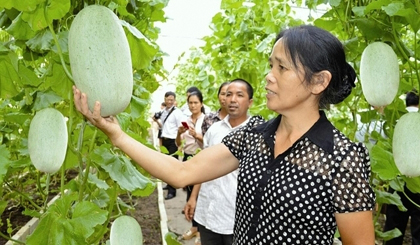Agricultural branding: a must for enhanced competitiveness
A lack of branding for agricultural products makes it difficult for Vietnamese commodities to gain advantages and footholds in foreign markets. For that reason, building brands for agricultural products is highly necessary to increase competitiveness for agricultural commodities produced in Vietnam.
 |
| Lang Son farmers inspect a Bao Khue melon greenhouse cultivating model at Lang Son Science and Technology Application Centre in Lang Son City, the northern province of Lang Son. (Credit: NDO) |
According to the Department of Agro-product Processing and Marketing, under the Ministry of Agriculture and Rural Development (MARD), around 90% of Vietnam's agricultural products are still exported in raw forms at lower prices than those of other countries. Notably, over 80% of agricultural products have not been integrated with a brand, sold without logos or labels and sold internationally using foreign branding.
Statistics from the National Office of Intellectual Property, under the Ministry of Science and Technology, show that in more than 90,000 trademarks of all kinds registered for protection in Vietnam, only about 15% of them belong to domestic enterprises. This is a big disadvantage, weakening Vietnamese agricultural products’ competitiveness and forcing the sector to face many disadvantages.
The cause of this situation is partly due to limited awareness on branding strategies from agro enterprises. They have failed to clearly understand the role and significance of building and protecting agricultural product brands, while still implementing branding strategies without cooperation or consensus.
At the same time, conditions for branding have not been determined for most agricultural products, such as products must be in a large enough volume with stable productivity, uniform quality, and ensured food hygiene, as well as at competitive prices. Distribution channels must be organised in harmony with reasonable interests for all participants.
However, at present, even Vietnam’s major agricultural products, such as rice, seafood, and coffee, are still struggling with the issues related to planning raw material areas and quality assurance.
Currently, the quality of agricultural products is not just being spread through word-of-mouth, but more importantly, the product must be clearly labelled and packaged, showing sources of origin. Thus, signing exclusive trademarks and branding should be prioritised to win the trust of consumers.
Farmers themselves cannot do the work alone without the important role and participation from the business community. The latter need to coordinate with farmers in agricultural product branding, linking all stages of production, processing and consumption, especially quality control. At the same time, businesses also need to "shake hands" to jointly invest in science and technology, while gradually restricting the export of raw materials and gradually shifting to processed export to improve products’ value and create sustainable brands.
To assist the branding journey, the MARD has recently developed a programme for the development of major agricultural product brands up to 2020, with a focus on five key products, including mango, dragon fruit, tea, coffee and tra fish. In addition, for rice exports, the ministry has launched a national logo designing contest to seek for Vietnam’s national rice brand.
Vietnam has lagged behind many other countries in building brands for agro products, however it is better late than never, particularly in the context of deepening international economic integration. The orientation will facilitate functional agencies to develop reasonable policies to help businesses and farmers improve branding conditions, thereby giving them the opportunity to expand branding to other agricultural products in the coming time.
(Source: NDO)
 về đầu trang
về đầu trang






